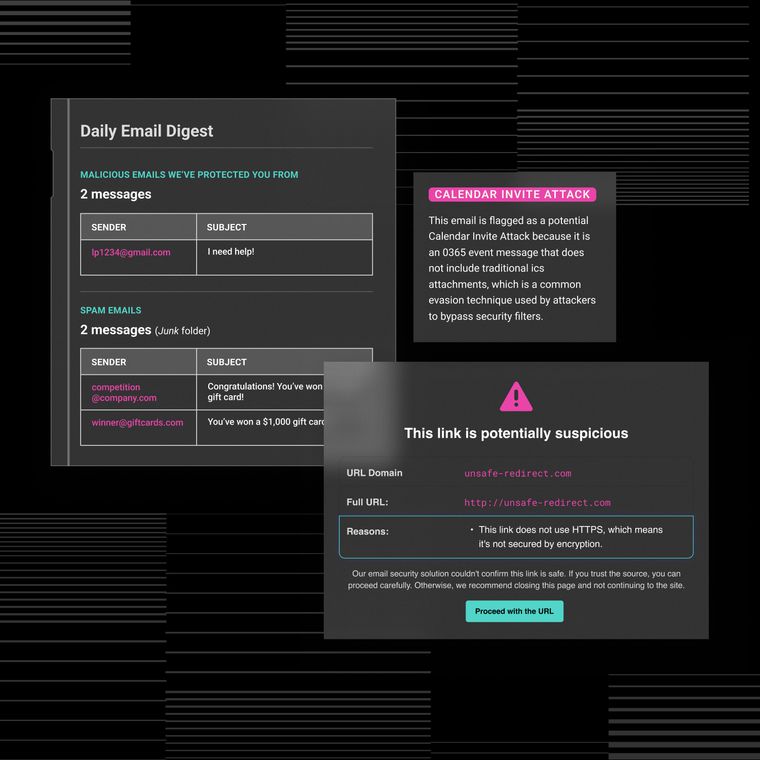The Ultimate Guide to Implementing Effective Cyber Awareness Training Programs
Learn to create a cyber awareness training program that teaches employees to stop threats before they spread.
June 12, 2025
Effective cyber awareness training turns employees from passive participants into active defenders. Understanding the importance of security awareness training is key. However, for training to truly work, it must reflect the unique responsibilities of each role.
Executives need strategic simulations. Security teams benefit from technical, scenario-based exercises. Compliance leaders require content that connects regulatory requirements to daily operations.
When training is tailored to these needs and delivered in digestible formats across channels, it builds a stronger, more resilient security culture.
The best programs follow a layered approach:
Foundational: Core security principles for everyone.
Role-specific: Content aligned to job functions and risk profiles.
Advanced: Deep dives for security and compliance professionals.
And with new tools like Abnormal’s AI Phishing Coach, organizations can reinforce awareness through contextual, real-time guidance, training employees exactly when and where threats occur.
Cyber awareness training isn’t a one-time task. It’s an ongoing initiative designed to shift behavior, build a security-first mindset, and help your team make the right decisions when it matters most.
Why Cyber Awareness Training Is More Critical Than Ever
The threat landscape is evolving fast, and your training programs need to keep up.
AI Is Changing the Risk Profile
Generative AI introduces new threats, from prompt-based data exposure to misuse of unstructured content, including AI-driven phishing threats. The exploitation of AI tools by attackers underscores the need for training that helps employees spot misuse and understand the risks tied to generative tools, highlighting the power of generative AI in sophisticated attacks.
Gartner highlights a growing focus on securing AI systems, underscoring the need for training that helps employees spot misuse and understand the risks tied to generative tools.
Ransomware Is Growing More Advanced
Modern ransomware campaigns use double extortion and supply chain exploits.
The Cloud Security Alliance reports a spike in attacks on healthcare, financial services, and critical infrastructure, raising the stakes for early detection and response.
Security Is a Team Effort
IBM notes cybersecurity is now a cross-functional one. Training should drive shared accountability across teams, not just awareness.
Supply Chains Are a Growing Weak Point
The World Economic Forum warns that third-party risk is accelerating. Awareness programs must prepare employees to recognize vendor threats, follow safe communication practices, and focus on supply chain attack prevention.
Human Error Remains the Top Risk
Human error still drives the most breaches, emphasizing the need for human risk mitigation. The workforce remains a security vulnerability.
The best defense? Ongoing, role-specific cyber awareness training that equips employees to recognize threats and respond with confidence.
Cyber awareness training isn’t a checkbox. It’s a strategic layer of defense that builds organization-wide resilience.
Core Components of Cyber Awareness Training
Effective cyber awareness training programs combine several key elements that form the foundation for secure behavior, regulatory compliance, and resilience against evolving threats.
Threat Education Modules
Training must teach employees to recognize both traditional and emerging cyber threats:
Phishing: Including sophisticated, AI-generated lures, and providing phishing prevention tips to empower employees.
Business Email Compromise (BEC): Identifying impersonation attempts and fraudulent requests.
Ransomware: Understanding modern tactics like double extortion and supply chain exploits.
Social Engineering: Spotting manipulation techniques used to extract sensitive information.
The Cloud Security Alliance highlights the surge in advanced ransomware attacks, reinforcing the need for updated, threat-relevant content in these modules.
Behavior Reinforcement Tools
Knowledge must translate into consistent, secure habits. Fostering ongoing cybersecurity awareness is essential. Training programs should include:
Phishing Simulations: Realistic testing that gauges awareness and reinforces vigilance.
Microlearning & Nanolearning: Bite-sized, ongoing content delivery that keeps concepts fresh.
Incident Reporting Workflows: Clear guidance for identifying and escalating suspicious activity.
Security Hygiene Training: Covering MFA, password management, safe browsing, and more.
According to NIST, tracking simulation results, reporting frequency, and behavioral shifts over time is key to measuring success.
Compliance and Policy Alignment
Cyber awareness training also plays a critical role in satisfying regulatory obligations:
GDPR: Educating employees on lawful data handling and subject rights.
HIPAA: Ensuring healthcare staff understand and apply security safeguards.
Privacy by Design: Embedding data protection principles into product and process development.
Breach Notification Protocols: Defining employee responsibilities during a security incident.
The U.S. Department of Health and Human Services emphasizes that HIPAA-compliant training should cover practical, policy-driven controls like access management and audit trails.
How to Create a Comprehensive Cyber Awareness Training Program
An effective cyber awareness training program starts with a strategy.
Before rolling out content, assess your current security posture, define measurable objectives, and factor in your organization's culture, structure, and regulatory requirements.
Most importantly, treat training as a continuous journey, not a one-off event.
Align Training to Roles and Responsibilities
Generic training rarely moves the needle. Drive real behavior change by tailoring programs to reflect the specific needs and responsibilities of different functions.
CISOs need training that reinforces strategic leadership:
Executive-level breach simulations that model crisis decision-making.
Industry-specific threat briefings to support risk prioritization.
Guidance on articulating security priorities to the board.
IT Security Managers benefit from practical, technical content:
Deep dives into emerging threat vectors, including credential phishing insights.
Team-based incident response simulations.
Sessions on building and reporting meaningful security metrics.
Compliance Officers require actionable training on regulations and audits:
Workshops on translating compliance frameworks into practice.
Audit simulation exercises.
Regulatory update sessions to stay current with evolving standards.
Role-based training ensures content is relevant, actionable, and aligned with day-to-day decision-making.
Deliver Training That Engages and Sticks
Even the best-designed content fails if it’s ignored or quickly forgotten. The most successful training programs prioritize delivery methods that are interactive, relevant, and easy to access.
To overcome common adoption challenges, such as administrative burden, low engagement, and stale content, consider the following strategies:
Use managed programs to offload logistics while maintaining content quality.
Leverage varied formats like videos, simulations, and gamification to reach different learning styles.
Ensure all content is role-specific, increasing its immediate relevance.
Offer mobile-friendly options so employees can learn when and where it works best.
Shift to a continuous learning model, using short, recurring modules instead of annual refreshers.
Common training formats include:
In-person workshops for collaborative exercises.
Virtual instructor-led sessions for distributed teams.
Self-paced online modules for foundational topics.
Interactive simulations to reinforce behavior through action.
Mobile microlearning for just-in-time updates.
Interactive, context-aware training builds long-term awareness and behavioral change, supporting not just compliance but operational resilience.
Measure Program Effectiveness
To understand what's working and where to improve, track a mix of qualitative and quantitative metrics, including email security metrics:
Completion and assessment rates
Phishing simulation performance
Incident reporting trends
Real-world security event reduction
Employee feedback and qualitative insights
Regularly review and refine your training program based on these signals to ensure it evolves alongside the threat landscape and your organization.
How to Measure Effectiveness and Drive Continuous Improvement
Cyber awareness training must be evaluated for compliance and actual behavior change to deliver real impact. Measuring outcomes helps demonstrate ROI, uncover improvement areas, and adapt to shifting threats.
Key Metrics That Show What’s Working
Quantitative metrics, such as email security metrics, are a critical starting point for evaluating program effectiveness. These indicators help track behavior change at scale and highlight areas that need further attention:
Phishing Simulation Outcomes: Track click rates before and after training.
Incident Reporting Rates: Monitor how often employees report suspected phishing or security events, both simulated and real, as a sign of increased vigilance.
Security Incident Trends: Review the frequency and nature of human error–driven incidents to assess whether training is influencing day-to-day actions.
Completion Rates: Gauge engagement across the organization, keeping in mind that high participation doesn't always equate to changed behavior.
Together, these metrics provide a baseline view of your training program’s reach and impact—and set the stage for deeper behavioral analysis.
Going Deeper With Qualitative Insights
Quantitative data doesn’t always tell the full story. Qualitative methods help organizations understand why behaviors are changing—or not:
Pre/Post Assessments: Evaluate knowledge retention, though knowledge alone doesn’t guarantee secure behavior.
Surveys and Feedback: Capture employee sentiment, attitude shifts, and perceived confidence post-training.
Focus Groups: Provide rich, contextual insights into training relevance and obstacles.
Targeted Assessments: Measure specific behaviors in high-risk departments or roles.
According to the Cybersecurity Journal, mature organizations combine these data sources into dashboards that track phishing resilience, incident reporting, and behavioral indicators over time. Some also use weighted scoring models to produce a composite effectiveness score, providing a more holistic view of impact.
Feedback Loops That Power Training Evolution
Building a feedback-driven improvement cycle ensures your program stays relevant and effective:
Use post-training surveys and informal feedback channels like manager interviews or focus groups.
Prioritize feedback that reveals content gaps, technical friction, or engagement drop-off.
Refresh content frequently, especially to reflect new threats or regulatory changes.
When organizations commit to continuous improvement, their training programs become more than a compliance checkbox. They become a dynamic part of the security strategy.
Training Is Your First Line of Human Defense
Cyber awareness training is no longer optional—it’s foundational. In today’s rapidly evolving threat landscape, security-savvy employees are just as critical as strong technical controls.
To recap:
Training must evolve to address risks tied to AI, ransomware, and social engineering.
Employees are defenders, and training empowers them to detect and respond to threats effectively.
Continuous learning beats annual checklists, especially when delivered through interactive, role-specific methods.
Behavioral metrics reveal effectiveness, guiding program adjustments and investments.
Supporting employees with real-time, in-the-moment coaching can dramatically enhance the effectiveness of your program. That’s why we built the AI Phishing Coach, a contextual training solution that teaches employees how to spot threats as they happen, not after.
Ready to make every click a learning opportunity? Explore how the AI Phishing Coach helps turn your workforce into your strongest security layer.
Related Posts
Get the Latest Email Security Insights
Subscribe to our newsletter to receive updates on the latest attacks and new trends in the email threat landscape.


